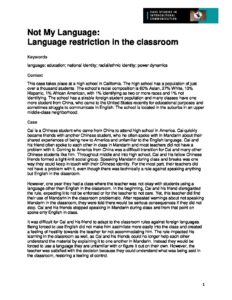Not My Language: Language restriction in the classroom
Keywords
language; education; national identity; racial/ethnic identity; power dynamics
Context
This case takes place at a high school in California. The high school has a population of just over a thousand students. The school’s racial composition is 60% Asian, 27% White, 10% Hispanic, 1% African American, with 1% identifying as two or more races and 1% not identifying. The school has a sizable foreign student population and many classes have one more student from China, who came to the United States recently for educational purposes and sometimes struggle to communicate in English. The school is located in the suburbs in an upper middle-class neighborhood.
Case
Cai is a Chinese student who came from China to attend high school in America. Cai quickly became friends with another Chinese student, who he often spoke with in Mandarin about their shared experiences of being new to America and unfamiliar to the English language. Cai and his friend often spoke to each other in class in Mandarin and most teachers did not have a problem with it. Coming to America from China was a difficult transition for Cai and many other Chinese students like him. Throughout middle and into high school, Cai and his fellow Chinese friends formed a tight-knit social group. Speaking Mandarin during class and breaks was one way they could keep in touch with their Chinese identity. For the most part, their teachers did not have a problem with it, even though there was technically a rule against speaking anything but English in the classroom.
However, one year they had a class where the teacher was not okay with students using a language other than English in the classroom. In the beginning, Cai and his friend disregarded the rule, expecting it to not be enforced or for the teacher to not care. Yet, this teacher did find their use of Mandarin in the classroom problematic. After repeated warnings about not speaking Mandarin in the classroom, they were told there would be serious consequences if they did not stop. Cai and his friends stopped speaking in Mandarin during class and from that point on spoke only English in class.
It was difficult for Cai and his friend to adapt to the classroom rules against foreign languages. Being forced to use English did not make him assimilate more easily into the class and created a feeling of hostility towards the teacher for not accommodating him. The rule impacted his learning in the classroom as well, as Cai and his friends could no longer help each other understand the material by explaining it to one another in Mandarin. Instead they would be forced to use a language they are unfamiliar with or figure it out on their own. However, the teacher was satisfied with the decision because they could understand what was being said in the classroom, restoring a feeling of control.
Discussion Questions
As you consider this case, discuss:
- What cross-cultural instructional strategies could the teacher use to accommodate foreign students in the classroom?
- Does being forced to use a language you are not proficient in erase part of one’s identity?
- Is the teacher justified in asking students to use English at all times in the classroom?
- What impacts does forcing students to use an unfamiliar language have on their education or learning, if any?
- How do the power dynamics between students and teachers influence situations in which there are language conflicts in the classroom?
Additional Resources
Additional recommended resources to explore the central themes in this case are available.
- Cunningham, Clare. “Why Teachers Shouldn’t Be Afraid of Other Languages Being Spoken in the Classroom.” The Conversation, 8 July 2020.
- Farnsworth, B. (2018, June/July). “Enhancing the Quality of the International Student Experience.” Retrieved September 30, 2020.
- Textor, C. (2019, November). “Number of college and university students from China in the United States from academic year 2008/09 to 2018/19.” Retrieved September 30, 2020.
- Wang, T. (2020, July 17). “Chinese students who once set their sights on US schools now weigh other options.” Retrieved September 30, 2020.
Corresponding Author
Dingman, Spencer, American University, Washington DC, USA. Email: sd7174a@student.american.edu


